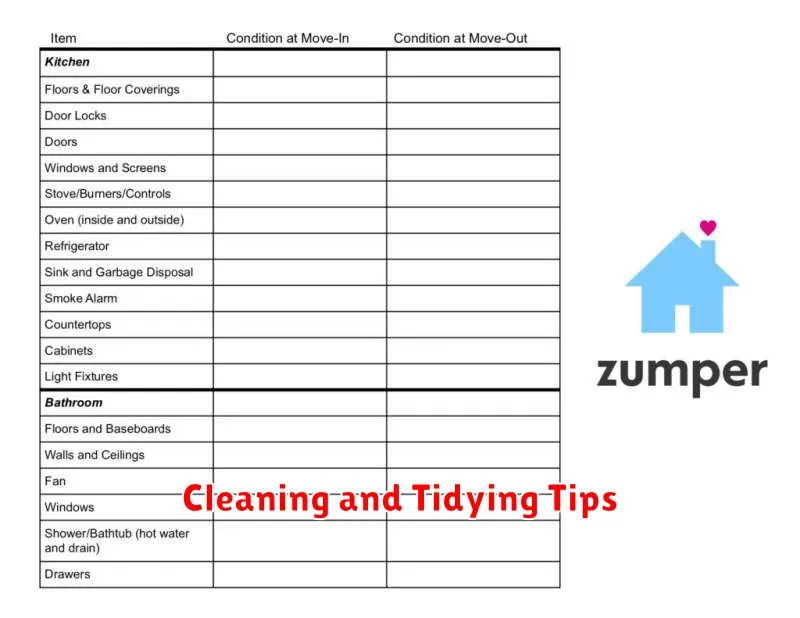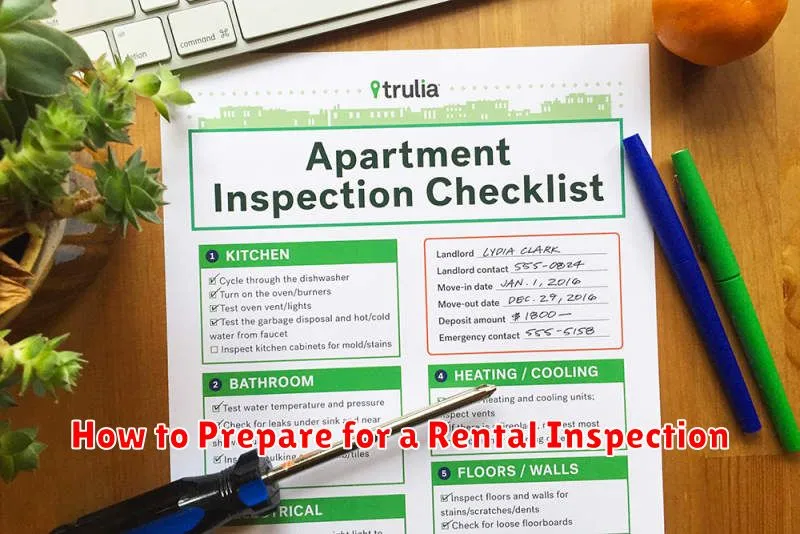Preparing for a rental inspection can feel stressful, but with the right approach, you can ensure a smooth and successful experience. This guide provides a comprehensive overview of how to prepare for a rental inspection, covering everything from cleaning and repairs to communication with your landlord. Understanding the rental inspection checklist and knowing what landlords look for during an inspection are crucial for maintaining a positive tenant-landlord relationship and securing your security deposit. Whether this is your first inspection or you’re a seasoned renter, these tips will help you navigate the process with confidence.
A rental inspection, sometimes called a property inspection, is a routine check performed by your landlord or property manager to assess the condition of the rental unit. These inspections allow landlords to identify necessary repairs, ensure lease compliance, and address any potential issues before they escalate. By understanding how to prepare for a rental inspection, you can demonstrate your responsibility as a tenant, minimize the risk of deductions from your security deposit, and maintain a positive relationship with your landlord.
Why Inspections Happen Regularly
Regular inspections are crucial for maintaining safety, ensuring compliance, and promoting efficiency. They help identify potential hazards, prevent accidents, and ensure adherence to established regulations and standards. Whether it’s a building inspection, a safety audit, or a financial review, regular inspections provide a proactive approach to risk management and problem-solving.
Through routine inspections, small issues can be identified and addressed before they escalate into larger, more costly problems. This proactive approach saves time and resources in the long run. Furthermore, regular inspections promote accountability and transparency, fostering a culture of continuous improvement.
Ultimately, regular inspections contribute to a safer, more efficient, and compliant environment. They are an investment in preventing future problems and ensuring long-term stability and success.
Understanding What Landlords Check
Landlords thoroughly vet prospective tenants to protect their investment and ensure a smooth rental experience. They primarily focus on verifying your ability to pay rent consistently and on time. This involves checking your credit report for past payment history, outstanding debts, and credit score. A good credit score indicates financial responsibility. Landlords also verify your income, often requiring proof of employment, pay stubs, or bank statements, to ensure you earn enough to comfortably afford the rent. Finally, they’ll contact your previous landlords for references to understand your rental history, including how you treated the property and whether you paid rent on time and followed the terms of your lease.
Beyond financial stability, landlords assess your overall suitability as a tenant. This involves checking your background for any criminal history or prior evictions. While the specific criteria vary by state and landlord, a history of serious offenses or evictions can significantly impact your application. Some landlords may also conduct a social media check to gain further insight into your lifestyle and behavior. It’s important to present yourself honestly and professionally throughout the application process.
Understanding what landlords look for allows you to prepare in advance and increase your chances of approval. Gathering necessary documents like pay stubs, bank statements, and contact information for previous landlords can streamline the application process. Addressing any potential red flags proactively, such as a low credit score or past eviction, with an honest explanation can also help build trust with the landlord. By being prepared and transparent, you can demonstrate that you are a responsible and reliable tenant.
Cleaning and Tidying Tips

Maintaining a clean and tidy space promotes a healthier and more productive environment. Decluttering is a crucial first step. Remove unnecessary items from surfaces, shelves, and drawers. Group similar items together and find designated storage spaces for everything. Regularly discarding or donating unwanted possessions prevents clutter from accumulating again.
Cleaning should be done routinely. Focus on high-traffic areas like kitchens and bathrooms. Wipe down surfaces, sweep or vacuum floors, and empty trash bins frequently. A regular cleaning schedule, even if it’s just for a few minutes each day, can prevent dirt and grime from building up and becoming overwhelming.
Organization is key to maintaining a tidy space. Utilize storage solutions like shelves, drawers, and containers to keep items neat and accessible. Labeling containers clearly allows for easy identification and retrieval of items. By implementing these simple tips, you can create a clean and organized environment that contributes to overall well-being.
Fixing Small Issues in Advance

Addressing minor problems before they escalate can save significant time, resources, and frustration in the long run. Proactive maintenance, whether in personal life or professional settings, involves identifying and rectifying small issues early on. This can range from patching a small hole in a roof before it causes a leak to addressing a minor software bug before it affects system performance. By taking the time to address these small issues, we prevent them from becoming larger, more complex, and more expensive problems down the line.
Early intervention is key to effective proactive maintenance. Developing a keen eye for detail and implementing regular checks can help identify potential problems in their infancy. This might involve regularly inspecting equipment, reviewing processes, or actively soliciting feedback. Addressing these issues promptly minimizes disruption and allows for more efficient use of resources. Ignoring small issues can often lead to a snowball effect, where seemingly minor problems compound and create a much larger, more difficult situation to manage.
Ultimately, a proactive approach to problem-solving saves time and money. While it may require an initial investment of time and effort, the payoff in preventing larger, more disruptive issues is substantial. Consistent attention to detail and a commitment to addressing small problems promptly builds a foundation for long-term success and stability.
Respecting Privacy and Legal Boundaries
Respecting individual privacy and adhering to legal boundaries are crucial aspects of ethical behavior, both online and offline. This includes understanding and complying with data privacy laws like GDPR and CCPA, as well as refraining from collecting, using, or sharing personal information without proper consent. Unauthorized access, distribution, or manipulation of private data is illegal and carries severe consequences.
Protecting privacy extends beyond personal data and encompasses respecting physical and digital boundaries. This means avoiding intrusive surveillance, respecting confidential communications, and refraining from accessing or sharing information without explicit permission. It is essential to treat others with the same level of privacy you expect for yourself. This fosters trust and promotes a positive and respectful environment.
Ultimately, respecting privacy and legal boundaries is about demonstrating integrity and ethical responsibility. By being mindful of these principles, we contribute to a safer and more respectful society.
Documenting the Condition Yourself
Thorough documentation is crucial for effectively managing and addressing any condition. Keeping detailed records of symptoms, their onset, duration, and severity, along with any treatments attempted, can help you understand patterns and triggers. This information is invaluable when communicating with healthcare professionals, as it provides a clear picture of your experience and allows for a more accurate diagnosis and treatment plan. Be sure to record the date and time of each entry for precision.
While documenting your condition, be as specific and objective as possible. Rather than writing “felt bad,” describe the specific sensation, like “sharp pain in lower left abdomen.” Include details about what you were doing when the symptoms appeared, what made them better or worse, and any other relevant information. Avoid making subjective judgments or diagnoses, instead focusing on factual observations. This factual record will be more helpful to both you and your medical team.
Consider various methods for documentation. A dedicated journal, a spreadsheet, or even a note-taking app on your phone can be effective tools. Choose a method that is easy for you to maintain consistently. Some people find it beneficial to organize their information into categories, such as symptoms, medications, and doctor visits. Find a system that works best for you and stick with it for consistent tracking of your condition.
After the Inspection: What to Expect
After a home inspection, you’ll receive a detailed report outlining the inspector’s findings. This report typically includes descriptions and, sometimes, photographs of any issues discovered, ranging from minor maintenance needs to significant structural problems. Pay close attention to the severity levels assigned to each issue, as this will help you prioritize any necessary repairs or negotiations with the seller.
Once you have the report, you can decide how to proceed. If the inspection reveals only minor issues, you might choose to move forward with the purchase as planned. However, if major problems are identified, you have several options. You can request the seller to make the necessary repairs, negotiate a lower purchase price to accommodate the repair costs, or, in some cases, terminate the purchase agreement altogether.
Remember, the inspection report is a valuable tool to help you make an informed decision. It’s recommended to carefully review the findings with your real estate agent and discuss your options before making any final decisions. Understanding the implications of the inspection report is crucial to ensuring a smooth and successful home buying experience.

